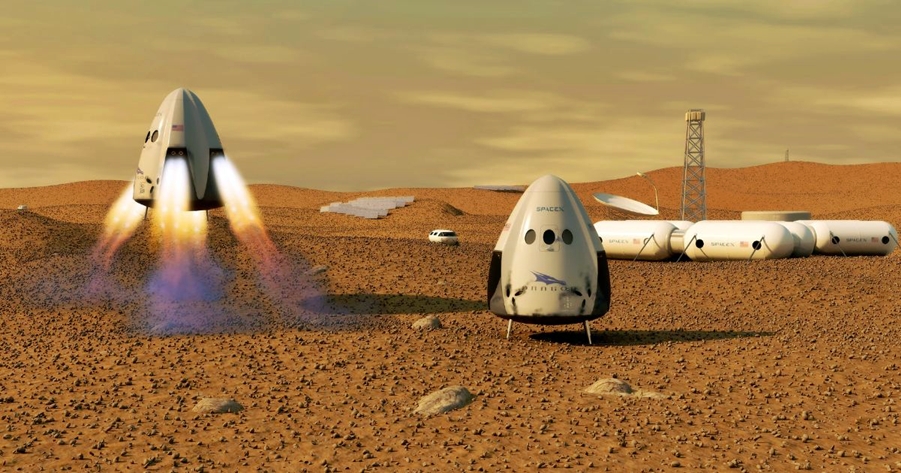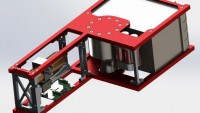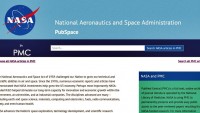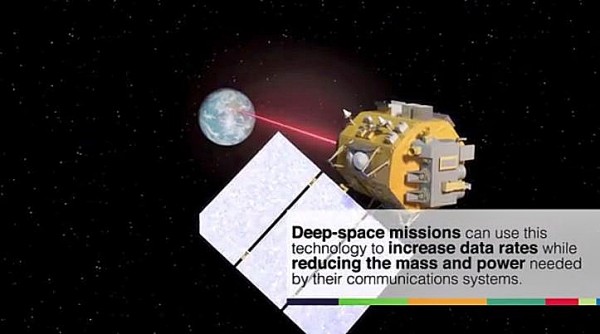NASA Eyes ‘Photonics’ and Laser Communications to Talk to Mars-bound Spacecraft
| Arthur Dominic Villasanta | | Oct 23, 2016 09:26 AM EDT |
(Photo : NASA) Probe talking to the Earth using a laser.
NASA is turning to a little known field called "photonics" to solve the vexing problem of how to dramatically speed-up communications with spacecraft, especially manned spacecraft on long space voyages such as those planned for Mars in the late 2020s.
Photonics explores the many applications of generating, detecting and manipulating photons, or particles of light that make up laser beams.
Like Us on Facebook
One major NASA priority is to use lasers to make space communications for both near-Earth and deep-space missions more efficient. NASA's communications systems have matured over the decades, but they still use the same radio-frequency (RF) system developed in the 1950s.
After more than 50 years of using solely RF, NASA is investing in new ways to increase data rates while also finding more efficient communications systems.
Photonics may provide the solution.
Several centers across NASA are experimenting with laser communications, which has the potential to provide data rates at least 10 to 100 times better than RF. These higher speeds will support increasingly sophisticated instruments and the transmission of live video from anywhere in the solar system.
They'll also increase the bandwidth for communications from human exploration missions in deep space, such as those associated with travel to Mars.
NASA's Goddard Space Flight Center in Maryland launched the first laser communications pathfinder mission in 2013. The Lunar Laser Communications Demonstration (LLCD) proved that a space-based laser communications system was viable and that the system could survive both launch and the space environment.
The mission was short-lived by design, as the host payload crashed into the lunar surface in a planned maneuver a few months after launch.
The Goddard team is now planning a follow-on mission called the Laser Communications Relay Demonstration (LCRD) to prove the proposed system's longevity. It will also provide engineers more opportunity to learn the best way to operate it for near-Earth missions.
"We have been using RF since the beginning, 50 to 60 years, so we've learned a lot about how it works in different weather conditions and all the little things to allow us to make the most out of the technology, but we don't have that experience with laser comm," said Dave Israel, Exploration and Space Communications architect at Goddard and principal investigator on LCRD.
"LCRD will allow us to test the performance over all different weather conditions and times of day and learn how to make the most of laser comm."
Scheduled to launch in 2019, LCRD will simulate real communications support, practicing for two years with a test payload on the International Space Station and two dedicated ground stations in California and Hawaii.
The mission could be the last hurdle to implementing a constellation of laser communications relay satellites similar to the Space Network's Tracking and Data Relay Satellites.
Missions to deep space impose special communication challenges because of their distance from Earth. The data return on these missions slowly trickles back to the ground a little at a time using radio frequency.
Laser communications could significantly improve data rates in all space regions, from low-Earth orbit to interplanetary.
JPL's concept called Deep Space Optical Communications (DSOC), focuses on laser communications' benefits to data rates and to space and power constraints on missions.
TagsPhotonics, laser communications, NASA, space communications, radio-frequency, Lunar Laser Communications Demonstration, Laser Communications Relay Demonstration
©2015 Chinatopix All rights reserved. Do not reproduce without permission
 Mars Astronauts Face Real Danger from Cosmic Ray Brain Damage
Mars Astronauts Face Real Danger from Cosmic Ray Brain Damage Water-powered Satellite to Orbit the Moon
Water-powered Satellite to Orbit the Moon When Aliens Call, We Shouldn’t Answer, Reasserts Stephen Hawking
When Aliens Call, We Shouldn’t Answer, Reasserts Stephen Hawking First Images Ever of Jupiter’s North and South Poles Lead to Unique Discoveries
First Images Ever of Jupiter’s North and South Poles Lead to Unique Discoveries NASA Places its Priceless Research Online on PubSpace, and it's Free
NASA Places its Priceless Research Online on PubSpace, and it's Free
EDITOR'S PICKS
-

Did the Trump administration just announce plans for a trade war with ‘hostile’ China and Russia?
-

US Senate passes Taiwan travel bill slammed by China
-

As Yan Sihong’s family grieves, here are other Chinese students who went missing abroad. Some have never been found
-

Beijing blasts Western critics who ‘smear China’ with the term sharp power
-

China Envoy Seeks to Defuse Tensions With U.S. as a Trade War Brews
-

Singapore's Deputy PM Provides Bitcoin Vote of Confidence Amid China's Blanket Bans
-

China warns investors over risks in overseas virtual currency trading
-

Chinese government most trustworthy: survey
-

Kashima Antlers On Course For Back-To-Back Titles
MOST POPULAR
LATEST NEWS
Zhou Yongkang: China's Former Security Chief Sentenced to Life in Prison

China's former Chief of the Ministry of Public Security, Zhou Yongkang, has been given a life sentence after he was found guilty of abusing his office, bribery and deliberately ... Full Article
TRENDING STORY

China Pork Prices Expected to Stabilize As The Supplies Recover

Elephone P9000 Smartphone is now on Sale on Amazon India

There's a Big Chance Cliffhangers Won't Still Be Resolved When Grey's Anatomy Season 13 Returns

Supreme Court Ruled on Samsung vs Apple Dispute for Patent Infringement

Microsoft Surface Pro 5 Rumors and Release Date: What is the Latest?










